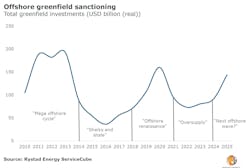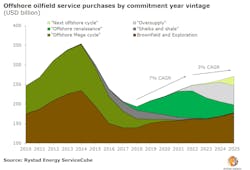Offshore drilling, subsea equipment pick-up may prove temporary
Offshore staff
OSLO, Norway – Global offshore oilfield services demand looks set to tail off after 2022, according to consultant Rystad Energy.
It predicts the market will slow from 7% growth per year in 2019-2022 to 3% from 2022-2025.
Audun Martinsen, head of Oilfield Service Research, said: “Just how things ultimately play out in the offshore market will depend to a large extent on whether OPEC, with help from Russia, will decide to take serious measures to stabilize the market over the next years.
“If the group decides to rein in production to protect commodity prices, momentum in the offshore market could continue. If not, the offshore renaissance party seems destined to come to an end in 2022.
“Higher oil prices were a primary cause of the recent upstream spending spree and – in keeping with the cyclical nature of this industry – the added production from those investments will soon help to put downward pressure on oil prices, which in turn will undermine field sanctioning activity post-2020.”
Currently oil and gas companies are intensifying offshore greenfield sanction, but from 2022, those projects – representing around 5 MMboe/d – will start to deliver production.
Four consecutive years of growth in the sector will likely lead to cost inflation in various sectors, potentially 10-15% above 2018 levels.
“The effect will be a noticeable slowdown of greenfield service purchases of platforms, subsea infrastructure, drilling rigs and vessels, causing the overall offshore service market growth rate to be cut in half,” Martinsen said.
“We estimate that investment commitments associated with offshore project sanctioning are likely to drop to between $70 billion and $80 billion per year – only half the amount forecast in 2020.
“Fewer projects sanctioned, as well as fewer completed from the ‘offshore renaissance period’ of 2018 through 2021, will likely cause the offshore service market to reach an inflection point in 2022.”
Rystad highlights subsea equipment, offshore drilling, and SURF (subsea umbilicals, risers and flowlines) as the most vulnerable, with engineering the sole segment likely to undergo a demand increase.
05/22/2019

